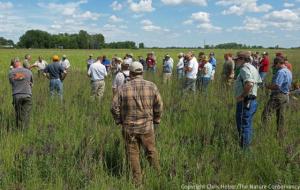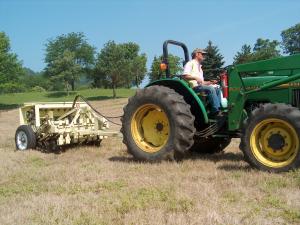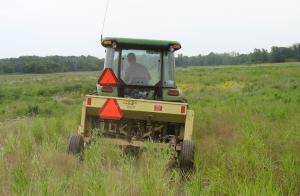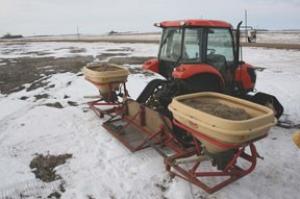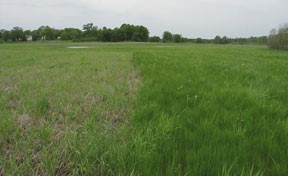What's Working for Conservation
Prairie Establishment
2025 Information
Soils Inversion for Organic Site Preparation - We have tried using a few organic site method preparation methods recommended by the

Xerces Society Organic Site Preparation for Wildflower Establishment | Xerces Society book to convert old fields dominated fields to prairie vegetatoin. I would recommend the following method on medium/well drained soils, not in low heavy soils. Areas where we have used this were smooth brome/spotted knapweed/Canadian thistle monocultures, and now there is a noticeable increase in plant and bird diversity post project (we have used this on 4 ac, 8 ac and currently have a 9 ac planting).
Soil Inversion method on Page 28 of the guide.
Recommend using on 9 ac or less.
Only use on medium/well drained soils. Wet and heavy isn’t as successful for native establishment.
Follow the Xerces timeline.
For those not experienced with a Moldboard, watch some YouTube videos to make it easier on yourself. Depth/positioning is all crucial. We used a 3 bottom plow.
Two to three weeks after plowing disc 4 times in different directions. We haven’t used a cultipacker, if you have time I see the benefit.
Immediately seed (day/night of if possible or next day). We have had some plantings interrupted by rain and notice the difference in areas where we were not able to seed within a few days. (Dan MacSwain, Washington County).
2020 Information
Inter-seeding: This inter-seeding project started with a 4 species native grass mixture planting back in June of 2009. The method we used was a spring
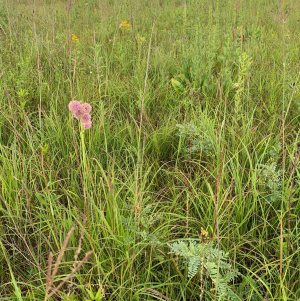
burn, applied *post grass herbicide at half rate to re-growth. Inter-seeded a full rate of rare and declining seed mix of grasses and flowers, and then hayed the site once in 2009 and multiple times in 2010. The project seemed to be successful, with about 2/3 of the species being present after 10 years. Some of the species included in the 20 sp. mix noted in a recent site visit included Wild Bergamot, Purple & white prairie clover, ox-eye, prairie coneflower, showy and stiff goldenrod, wild licorice, vervain, Canada milk vetch, prairie onion and black-eyed susans. It is likely that aster varieties will show up later in the fall. It is likely that some species survived the inter-seeding better than others. (Ryan Peterson, Kandiyohi SWCD)
2018 Information
Weed Competition: Weed pressure is often the number one concern from a landowner. A fall dormant seeding seems to keep weed pressure down the best as the cool season natives seem to grow right away in the spring and the prairie becomes established (ahead of the weeds) more quickly versus a late spring/early summer planting. When doing a late spring/early summer planting, using oats as a cover crop to compete with those early season weeds sure seems to help also. I also think a heavy dose of cool season native grasses is essential to include. We are constantly fighting brome or reed canary and sites with more cool season natives have less brome and reed canary grass long term. (Kevin Roth, BWSR)
2018 Information
Use of Cover Crops: Sites with fertile, wet, heavy soils and or with a composition of quack grass 20% or greater: When converting a field from non-native grass, you may want to plant a cover cop to give an additional year of tillage and spraying to help ensure a good kill of the brome, reed canary, and quack grass. If you plant a cover crop seed mixture, be sure to not plant alfalfa and wheat. Be sure to spray the cover crop area with glyphosate before you plant the cover crop and in August again before you till (sick) the site up again. Next follow the steps of either a fall dormant seeding of a spring seeding. The more times a landowner sprays the site, the better the brome and weed control will be. (Farm Bill Partnership Staff)
Invasive Plant Management: It’s not the seed harvest or planting that limits our capacity to do good restoration work, it’s the management of invasives after planting. As we’ve visited site after site over the years, that topic has remained at the top of everyone’s concerns.
There are basically two ways the issue manifests itself. First, we tend to rush the restoration process and not prepare the site in a way that will help prevent future weed issues. The worst issues usually occur when we are trying to eliminate existing vegetation other than annual crops. Too often, we don’t spend enough time eliminating the grasses or other invasives – and their seed bank – before planting our prairie vegetation. As a result, new plantings have an abundance of weeds that are difficult to control, especially because they’re now mixed in with the new plants we are trying to establish. Investing in several years of herbicide, disking, fire, and/or other combinations of treatments before planting can help eliminate most of the pre-existing vegetation and greatly improve the quality of new restoration sites.
When converting cropland to prairie, many of weed issues have already been dealt with by years of cultivation and weed control, but there are still steps we can take to help deal with potential future invasive species problems. The biggest of those is the elimination of as many invasive species populations around the borders of the restoration site as possible. Investing in the removal of Siberian elm trees, smooth brome, or other nasty plants from field edges can make future weed control efforts much more manageable.
The second major way we get into trouble with invasive species in restoration efforts is that we plant more acres than we can manage weeds on. This often happens because of funding – we get grant money to help pay for restoration work, but that funding usually comes with an aggressive timeline. We commit ourselves to planting a lot of acres quickly and then later realize we’ve just created a massive amount of land that requires invasive species control – which our grant funding doesn’t cover. In some cases we also get into trouble when we start feeling good about our ability to harvest large amounts of seed and figure we should plant as many acres as we can. …and then the weeds show up.
(Chris Helzer, The Prairie Ecologist post on “Grassland Restoration Network – Minnesota Style”)
2013-2014 Information
Prairie Seeding: The following are recommended steps for seeding prairie: Plant shallow, less than ¼” deep, try not to seed when soil is wet, if drilling use a native seed drill(not a grain drill), drive slow 3-5 mps, for uniform output keep drill boxes >1/3 full of seed. Apply 1.5 times the drilled seeding rate for broadcast seeding (Jason Selvog, Stearns SWCD and Dennis Pederson, Habitat Forever).
Brome Conversion: The following sequence has been an effective method of converting brome fields to native prairie by Pheasants Forever and Stearns SWCD - Year 1: Disk 2 times in mid-June, mow in late July, herbicide in early September, Heavy tillage in late October. Year 2: Disk in Early May, pack the site in early May, Buy the seed, and get it in the ground by mid to late May, Herbicide application within a week of seeding, mowing in July and August. A detailed fact sheet on this approach can be found at www.pheasantsforever.org (Jason Selvog, Stearns SWCD and Dennis Pederson, Habitat Forever).
Brome Conversion: For converting a brome field to prairie and preparing for fall seeding start as early as possible and stay focused. Disk in two direction to cut/stress the sod and level the ground in May. Kill with glyphosate as soon as it greens up uniformly. Do heavy tillage sometime in early August. Disk one more time after it greens up again. Field cultivate and pack in mid-October, dormant seed after November 1st. Mow aggressively the next season(Jason Selvog, Stearns SWCD and Dennis Pederson, Habitat Forever).
Canada Thistle Suppression: Using plant species functionally similar to Canada thistle such as yarrow, black-eyed Susan, gaillardia, yellow coneflower, tall cinquefoil, stiff goldenrod, prairie coreopsis, evening primrose, Maximillian sunflower, purple prairie clover, Canada milkvetch and Hoary Vervain in seed mixes were shown to effectively reduce the cover of Canada thistle the first two years after seeding prairie in North and South Dakota. These “spike” mixes had between 100-300 seeds per square foot (Jack Norland, NDSU from” Reduced Establishment of Canada Thistle Using Functionally Similar Native Forbs in Ecological Restoration 2013).
Dormant Seeding: Fall dormant seeding of mesic prairie can lead to a high dominance of forbs but also native cool-season grasses. In some cases it may be beneficial to increase seeding rates of warm season grasses by about ten percent to ensure that there is a balance of native warm and cool-season grasses in the planting (Dan Shaw, BWSR)
Inter-seeding: To inter-seed forbs into warm season grass dominated sites the following sequence is one method that has been successful for projects. First conduct a prescribed burn in the spring followed by an application of glyphosate at 1 quart/ac and then inter-seeding a few days to a week later. Repeated mowing in the spring can be conducted instead of herbicide treatment but may not be as effective. Follow-up mowing to around 5-inches later in the season will aid establishment (Dan Shaw, BWSR)
2008-2012 Information
Site Preparation: Properly preparing a restoration site is very important. Sites with an abundance of weed seeds in the soil, small or narrow sites surrounded by invasive species and/or woody plants can result in eventual failed restoration efforts even when everything else is done well. Taking the time to eliminate, or at least greatly reduce invasive species threats prior to seeding will save countless hours of labor later, and perhaps spell the difference between eventual success and failure (Lessons Learned from the TNC Grassland Restoration Network: 2003-2010)
Soybean Stubble: If possible we always recommend planting soybeans the year before the planned seeding. Soybean stubble works well and is relatively firm with less residue than from corn. If there are ruts in the field we work those areas lightly in the fall. It is much easier to seed and clip a field that is smooth rather than one that is rutted and rough. In the spring after the weeds emerge, and just prior to seeding, we recommend burning the weeds down with round-up. We always caution the landowner to burn down with round up only with no additives. In the past we have had a problem with the Coops adding 2-4,D with the roundup for a better kill. We found that when this was done it affected our stand due to the 2-4,D residual that killed some of the new prairie seedlings. We have found that seeding in the soybean stubble with a no-till drill works the best. We have had some success with broadcast seedings. But from our experience the broadcast seedings are more unpredictable compared to the drilled seedings, and the seed is not as evenly distributed. If the drill has coulters we lift the coulters as you only need the disc openers to achieve the correct seed depth. The coulters result in a loose seedbed with the seed being too deep. No matter the seed mix, we always use 0.5 bushel of oats as a nurse crop. We feel that the oats has several benefits including achieving a quick cover for erosion control. If the soils are a little wet during seeding and crust – the oats help break through the crust and allows the new seeding to come through. The oats also shades the new seeding during the hot dry part of the summer. We always recommend clipping the new seeding as soon as the oats reaches the boot stage. The first clipping which is usually in July should be at approximately four inches in height. Then approximately one month later a second clipping should be completed at approximately six to eight inches in height. We are clipping less the second time as some of the natives are starting to achieve some height and we do not want to clip them if possible. We do not recommend clipping after the middle of August and never after the first of September. We have had the best luck when we allow the seeding to achieve some growth before the killing frost. The seedings that were clipped late in the season have not been as good. I believe that late clipping results in winter kill on some sites. During the second year we always recommend that the seeding be clipped in mid June after the broadleaf’s flush and before they set seed. In future years just spot clip as needed to control noxious weeds like thistles. We have had excellent success when using these methods (Dan Arndt, Steele County SWCD).
For several years we have been encouraging landowners in urban areas to focus first on establishing graminoids in their restorations and then coming in later to add forbs. This approach enables them to treat all broad leaf “wildflowers” volunteers as the enemy. We avoid having landowners inadvertently protecting and nurturing plants such as sweetclover, birdfoot trefoil, hoary alyssum and the like, which landowners may think are pretty and beneficial elements of a seeding that included wildflowers, by encouraging them to kill off all forbs. True, we lose a few desirable species, but it seems to be working. Since most graminoids hold up much better under frequent mowing and burns, this also favors those approaches to manage young plantings. It also opens the door for the use of broadleaf herbicides in cases where it is needed. Once the graminoids are well established (in 4-6 years), landowners can interseed with wildflowers or simply plant plugs to provide seed stock. The latter approach ensures that they know exactly which plants are desirable (Chris Lord, Anoka Conservation District).
Soybeans fix nitrogen so following soybean production directly with native planting can encourage weeds the following years (Kristy Zajac, Redwood SWCD).
Canada Wild Rye: Canada wild rye is often seeded at rates that are too high allowing it to smother other native vegetation. As a result it should often be minimized in seed mixes (Kristy Zajac, Redwood SWCD).
Tree Burning: Be careful when burning piles of cut trees on sites in preparation of restoration as intensive burning can sterilize soils and encourage thick patches of weed growth (Kristy Zajac, Redwood SWCD).
Dormant Broadcast Seeding: At the 2008 Grassland Restoration Network workshop the participants were all able to agree upon a consistently successful seeding technique that works across the mixed-grass and tallgrass prairie locations represented at the workshop. Excepting extraordinary circumstances, the experience of network participants shows that a dormant season broadcast seeding onto Roundup Ready soybean stubble will always establish a diverse prairie plant community. That said, there are countless ways to achieve success, and establishment varies greatly from year to year and site to site even when identical methods are employed (Lessons Learned from the TNC Grassland Restoration Network: 2003-2010).
Timing of Seeding: What appears to be more important than the type of crop harvested from the field prior to seeding is the timing of that seeding. Seeding in the winter or early spring following harvest has become the most common timing, but seedings into late spring or even early summer can bring success, although sometimes the establishment can be slower. What does not appear to work well is seeding into a field that has been idled for a season or more. Seeding into old field conditions tends to result in higher than acceptable weed pressure, even if the field is tilled prior to seeding (Lessons Learned from the TNC Grassland Restoration Network: 2003-2010).
Forb vs Grass Ratio: One trap into which some have fallen, and now regret, is the use of high seeding rates of rhizomatous tall grasses in order to help battle weeds. While that kind of seeding can help outcompete weeds, it also results in a stand dominated by grasses – and low overall plant diversity. Trying to later increase forb abundance and diversity in a prairie restoration dominated by tall grasses has been found to be extremely difficult (Lessons Learned from the TNC Grassland Restoration Network: 2003-2010).
Islands of Diversity: To introduce more diversity into woodlands and prairies we have used potted plant materials in islands, in addition to seed. The drawback is higher maintenance with watering and weeding. The benefit is the ability to give the land users a tangible result early on in the establishment period (Gina Hugo, Sherburne SWCD).
Snow Seeding: We have really improved our seeding efficiency and the amount of forbs in the plantings through snow seeding. There are optimum conditions that seem to improve results:
- Seed late in the winter when the sun has a higher angle.
- Pick those days when it is partly to mostly sunny and 25 to 35 degrees.
- Too much wind (20+mph) may hamper your ability to seed.
- Too much snow may result in seed movement when it melts –anything less than a foot should be OK.
You must be ready to take advantage of these conditions. By ready, I mean the trucks are loaded and the equipment is on site shortly after daybreak, etc. You should be done seeding for the day around 1:00 P.M. or earlier to allow the sun to have time to warm the seed in the afternoon. Once the seed has been locked in by freezing night-time temperatures it can no longer move laterally. During further snow melt the seed will be pulled in when the top layer of soil is soft. There is no need for further tillage or packing (Detroit Lakes USFWS Wetland Management District).
Broadcast Seeding: Broadcast seeding later in the spring and early summer is also a proven method for prairie seeding. Based on the experience we have had, along with the other field stations and private contractors, there is a need for some sort of post seeding packing or light dragging to ensure the soil/seed contact. We have used a drag directly behind the implement that has the seeder with no packing, and then with packing(drum style or helicoil) (Detroit Lakes USFWS Wetland Management District).
Seedbed: Our preferred seedbed is untilled Glyphosate ready soybean stubble. Soybeans are a nitrogen fixer and the Glyphosate is a short-lived herbicide that leaves a clean seed bed with good fertility. This would be the case for new units as well as for older units without natives (Detroit Lakes USFWS Wetland Management District).
Planting into Brome: One particularly successful method to seed into existing cover such as brome grass is to do an early burn on a piece you wish to change, then promptly seed into the ash. Wait until the existing plant community is 4 to 8 inches high after the burn and then hit it with a high rate of Roundup. Early burn again in 4 years, hit the stand of introduced survivors when they are only 1 to 2 inches high with Roundup, and the transition will be complete!! While using this technique we have stumbled onto an interesting fact that adult warm season grasses will take a Roundup application even if they have leaves up as much as two inches. This information is helpful when trying to improve a poor seeding that already has some natives (Detroit Lakes USFWS Wetland Management District).
Loosening Compaction: Ensuring that compacted soils will be loosened before planting is important to ensure that water will infiltrate and roots will be able to expand. Power rakes are effective site preparation tools for small prairie plantings from seed. Depth adjustments allow for tiller removal prior to surface scarification (Steve Henry, East Otter Tail SWCD).
Cropping for Site Preparation: Growing glyphosate ready corn or soybeans for two years prior to seeding (particularly for existing brome fields). Just spraying of brome fields in preparation of seeding often has not been successful, some type of tilling is often needed and it is preferred that fields be in agricultural production before seeding (Renville SWCD).
Seedbed Preparation: A sequence that has worked well for seeding prairie following corn or soybeans involves field cultivation and cultipacking a few weeks before seeding (early May); seeding with a drill is conducted in late May or early June into establishing weeds. 5-7 days after seeding weeds are treated with glyphosate. This herbicide application decreases weed competition (Pheasants Forever).
Temporary Covers: Using temporary cover crops such as oats to stabilize sites until conditions are suitable has been successful when a fall seeding is planned. If clipped or harvested earlier in the season, remaining stubble can stabilize soil and prevent the need for additional mulch. Additional herbicide treatment may be needed for species such as Canada thistle before fall dormant seeding (Dan Shaw, BWSR)
Minimizing Weed Competition: When seeding in the spring installing seed shortly after the seedbed is prepared minimizes weed competition.
Disk anchoring mulch: Using disk anchored straw mulch or erosion control fabrics protect seedlings by promoting seed to soil contact, maintaining moisture levels and preventing the movement of soil.
Restoration Planning: A study is being conducted to determine if planting method (dormant broadcast, summer broadcast, or summer drill) and seed mix diversity (10, 20, or 34 species) can be optimized to both encourage establishment of native tallgrass prairie species and discourage invasion by nonnative species. The dormant broadcast method has consistently produced the greatest perennial forb cover of the three planting methods, but forb cover has not varied with diversity of the seed mix. By 2007 (2005 planting), warm-season grasses planted with the summer drill method seemed to have a slight edge over the dormant broadcast, but, as with forbs, diversity of the seed mix had no influence on cover. The summer broadcast had the lowest cover of warm-season grasses. In contrast, cover of cool-season grasses was greatest in plots planted with the high diversity seed mix, but was unaffected by planting method. To discourage invasion, we would like to favor the guild that has the largest negative effect on non-planted cover. In 2007, cool-season grasses had the greatest negative effects on non-planted cover across all three planting methods; warm-season grasses had a smaller and less consistent effect. These results suggest that in the early years of a new restoration, good cover of cool-season grasses may help prevent invasion by undesirable plants (Diane Larson, USGS, Adapted from an abstract submitted to the 2010 Minnesota-Wisconsin Invasive Species Conference).
Inter-seeding: Guidelines summarizing some of the most common techniques for inter-seeding prairie are found in Section 3 of the Native Vegetation Establishment and Enhancement Guidelines.

